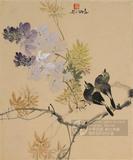元方厓墨竹 軸
推薦分享
資源連結
連結到原始資料 (您即將開啟新視窗離開本站)後設資料
- 資料識別:
- 故畫000326N000000000
- 資料類型:
- 類型:繪畫
- 型式:靜態圖像
- 著作者:
- 方厓
- 主題與關鍵字:
- 奇石 竹
- 出版者:
- 數位化執行單位:國立故宮博物院
- 格式:
- 本幅 115.1x36.6公分、全幅 59公分
- 關聯:
- 石渠寶笈三編(御書房),第七冊,頁3090&*故宮書畫錄(卷五),第三冊,頁244-245&*故宮書畫圖錄,第五冊,頁129-130&*方(活動於西元十四世紀中葉),吳中重居寺僧。張士誠據吳,遂避地住宜興保安寺。妙寫枯木竹石,一時士大夫契之不得,其筆墨尤難獲,與倪瓚過往甚密。竹石皆用禿筆,筆不求繁而韻自深遠。畫竹枝榦用重墨而葉色反澹。竹葉墨色,一筆之中自具深淺。坡上荊棘巖松,筆意極為渾樸,此皆可以名言;而圖中一片蕭瑟雅澹之氣,挹之若可出,則非語言文字可以為功。&*Fang yai was a monk at the Chung-chü monastery in Soochow. When Chang Shih-ch'eng took control of Soochow in his struggle with the future founder of the Ming dynasty, Fang fled to the Pao-an monastery in I-hsing. He was a wonderful painter of ancient trees, bamboos and rocks. His works were frequently sought after by high officials of the time, but in vain. He was an intimate friend of his contemporary, Ni Tsan. Both the bamboo and stones were painted with a worn brush. Though Fang Yai did not seek complexity, still the harmony is naturally profound and deep. In painting the bamboo branches and stems Fang Yai used heavy ink; the leaves were painted with dilute ink. The tone of the ink within a single bamboo leaf varies from dark to light. On the embankment are thorns and pines. The concept is extremely pure, but while all these aspects of the painting can be verbalized, it is impossible to express the lonely elegant spirit in words.
- 管理權:
- 國立故宮博物院
授權聯絡窗口
- 國立故宮博物院圖像授權、出版授權、影音資料授權-申請流程說明
http://www.npm.gov.tw/zh-TW/Article.aspx?sNo=03003061






